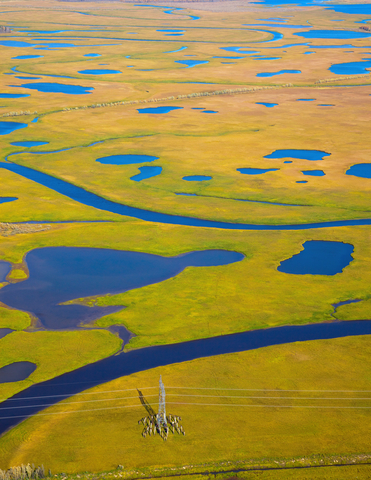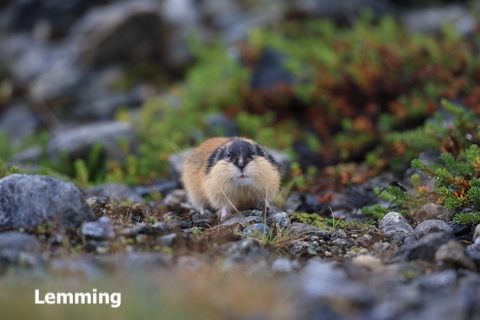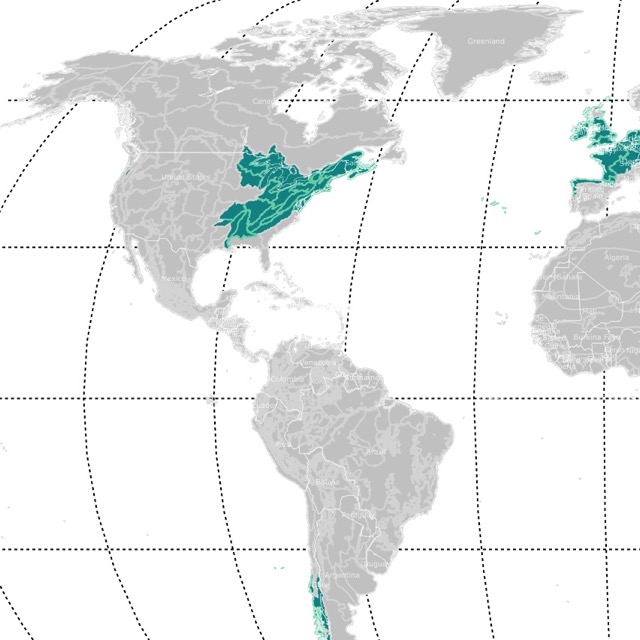World Map of Tundra
This map shows the world's Tundra in Pink. Tundra types have borders in different colors. For more detail, hover over the map. To take a closer look, zoom in. For more information, scroll down.
| Tundra Location | |||
|---|---|---|---|
| Tundra | Arctic Tundra | ||
| Alpine Tundra | Antarctic Tundra | ||

Tundra
Tundra comes from the Finnish word "tunturia", which means "treeless plain".
Tundra is the coldest biome, and it gets very little precipitation. Hence, some of the coldest and driest tundras are also deserts.
The Tundra is characterized by soils with very little nutrients and the season for growth and reproduction is very short.
It is important to note that flora and fauna in the tundra have very low diversity.
Tundra Location
Arctic Tundra Location

The Arctic Tundra encircles the Earth, and it is located between the Taiga and the Poles. Specifically the regions south of the ice caps in the Arctic, across Russia, Greenland, Iceland, a large portion of Canada, and Alaska are Tundra.
Alpine Tundra Location
Alpine Tundra is located on mountains worldwide, at altitudes where trees cannot grow.
It has a longer growing season than other tundra locations.
Unlike the Arctic Tundra, the soils in the Alpine Tundra are well-drained.
Antarctic Tundra Location
The Antarctic Tundra is also found on the shores that surround the Antarctic. Mainly in the subantarctic islands.
Tundra Climate
Tundra is so cold it gets almost no rain. Tundra is similar to deserts in that sense.
Arctic Tundra Climate

The temperatures in the Tundra are usually frigid, but summers can get warm. Tundra winters are dark and very long, about 6 to 10 months.
Winter temperatures are below 32°F (0°C), with an average of -30°F (-34°C).
Temperatures are so cold that there is a layer of permanently frozen ground called permafrost. Permafrost defines Arctic Tundra.
Summers thaw the top layer of soil for plants to grow in the summer. Nevertheless, the ground underneath, the permafrost, stays frozen.
Summer temperatures range between 37-54°F (3-12° C).
Precipitation ranges from 6 to 10in (150 to 250mm) per year. In the winter months, precipitation falls as snow. In the summer months, precipitation is rain or fog.
Permafrost and bogs store water in the Arctic Tundra.
Alpine Tundra Climate
Temperatures are typically between 10°F to 50°F (-12°C and 10°C). Cold winds have a substantial effect on living organisms.
The growing season is 180 days of the year, and nighttime is usually below freezing.
Sunrays in Alpine areas are more intense than in other tundra regions.
Precipitation is around 12in (300mm) per year; Conserve Energy
Antarctic Tundra Climate
The Antarctic Tundra is colder than the Arctic Tundra.
Tundra Vegetation
Vegetation in the Arctic and Alpine Tundra is similar.
Plants obtain their nutrients from decomposing matter.

Due to the harsh conditions, plants have to withstand strong winds, so they are short and group together to protect each other.
Near the poles, plants may complete their whole life cycle in 50 days when there is no ice or snow on the ground.
In the Arctic Tundra, due to the frozen ground or permafrost, plants do not have deep roots; this is another reason why they are small.
Due to a lack of pollinators in the Arctic and Antarctic, most plants reproduce asexually rather than sesually through pollination.
There are 1,700 types of plants in the arctic. Common plants include:
- Dwarf trees, including small birches
- Sedges, low shrubs, reindeer moss, liveworts, and grasses
- About 400 varieties of flowers. Flowers like poppies are about 3in (10cm).
- Because of the harsh conditions, lichen is common.
Tundra Wildlife
Animals have evolved to survive in tundra's freezing climate.
Mammals and birds have additional insulation with fat.
Because of the low temperatures, reptiles and amphibians are few or almost absent.
Arctic Tundra Wildlife

Animals breed and raise their young in a short period during the summer.
Some animals hibernate during the winter. Nevertheless, hibernation is not common because there is not enough food to hibernate.
Others, like birds, migrate. Thanks to this migration, populations in the Arctic oscillate throughout the year.
Because of the permafrost, few borrowing animals live in the tundra.
- Herbivores: voles, lemmings, caribou, squirrels, and arctic hares.
- Carnivores: arctic foxes, wolves, and polar bears.
- Migratory birds: snow buntings, loons, falcons, ravens, sandpipers, snowbirds, terns, harlequin duck, and gulls.
- Insects: mosquitoes, grasshoppers, flies, moths, blackflies, and arctic bumblebees.
- Aquatic Mammals: seals, walrus, beluga, whales
- Fish: salmon, trout, cod, and flatfish.
Due to melting snow and ice, tundra might be like a bog during the summer. The topsoil might have pools of stagnant water. In such places, it is common to see mosquito larvae thrive.

The mosquitoes themselves attract migrating animals like geese.
Organisms like Caribou (also known as Reindeer), elk, musk, and ox graze in other areas during winter and return in the summer.
Their return brings predators like wolverines and bears.
Organisms like the Snowy owl, polar bears, and the Arctic fox display beautiful white feathers or coats. The white color helps them camouflage with the snowy background.
Alpine Tundra Wildlife
Mammals include pikas, mountain goats, elk, sheep, and marmot.
Insects include beetles, grasshoppers, springtails, and butterflies; Berkley
Antarctic Tundra Wildlife
The Antarctic Tundra does not have large mammal visitors like the Arctic Tundra.
Typical organisms include seals and penguins. In the water, you can find cod and whales.
Tundra's Significance

Tundra is one of the major carbon dioxide sinks. This means it takes more biomass than it releases. This is because summers are so short the plant and animal matter does not decompose and does not release CO2 into the atmosphere.
Dead plants and animals can be frozen for thousands of years.
Unfortunately, the excess carbon dioxide in the atmosphere has contributed to climate change. Temperatures are warming, and permafrost is melting.
As it melts, more CO2 is released into the atmosphere.
Resources for Tundra Map
The shapefiles to create the map with ecoregions of the world were obtained from WWF. The shapefiles with the countries of the world were obtained from Natural Earth.
This map will be updated with new data! To receive updates on this and more nature maps, join my email list!!!!!!!
Made by Luz K. Molina with D3.js.







